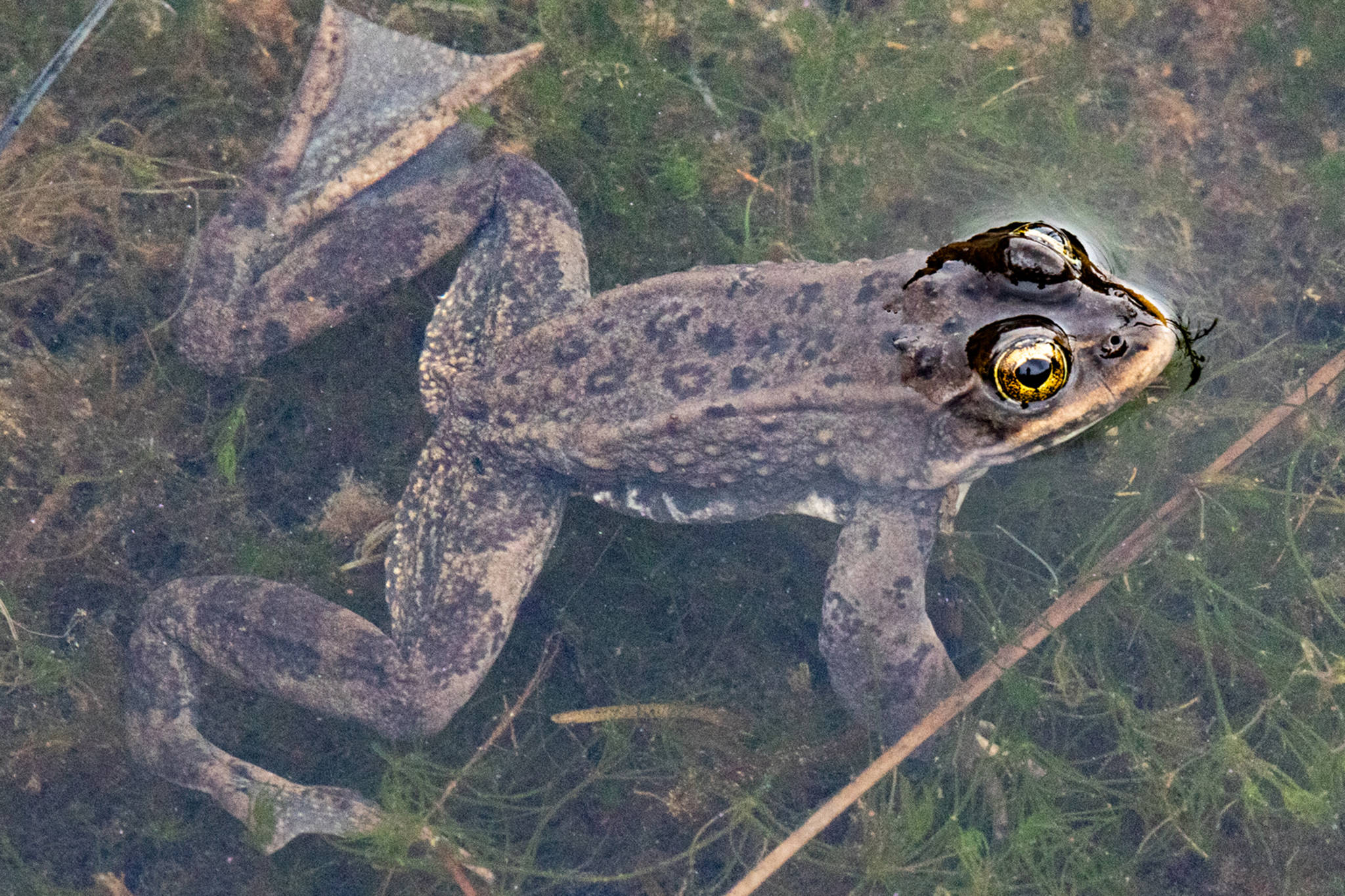A friend told me about a place where frogs were breeding, so I went to look. Not a frog in sight, except for a pair of legs disappearing under an algal mat. But I went back a few hours later, when the day had warmed up, and there they were — at least a dozen of them. The males were singing, if one can call it that. The “song” is a series of grunts, and different males sang on slightly different pitches. Occasionally, an eager male approached another frog and tried to grab it from behind, which is the usual position for fertilizing eggs as they emerge from a female. Males have sturdy forearms and strong thumbs for the purpose of holding a female in an embrace called amplexus. But as I watched, the male was kicked off by the presumed female; either she wasn’t ready to mate or “she” was really another “he.”
Those singing frogs are probably Columbia spotted frogs, which are native to Southeast Alaska, occurring chiefly in the transboundary river valleys. How they got to Juneau is unknown — possibly with help from humans. However, in recent years, they have been seen in several places in the Mendenhall Valley and, a few years ago, specimens were sent to an expert for genetic analysis, which determined the species identity.
[See photos taken by readers of Mother Nature in Alaska]
Columbia spotted frogs hibernate in ponds, springs, beaver dams and under stream cut-banks where it doesn’t freeze and moisture has adequate dissolved oxygen for them to breathe (through the skin). However, they are not dormant in winter; they can move around, sometimes several meters underwater to a new wintering spot. Come spring, males emerge first; they (unusual for amphibians) then choose an egg-laying site in warm, shallow water. Later-emerging females (up to almost 4-inches long) find the males’ chosen sites. They are larger than males (up to about 2.75 inches) and can lay hundreds of eggs in a globular mass.
Each fertilized egg is surrounded by two jelly layers and takes up to three weeks to hatch; the time is shorter when the water is warm. The tadpoles are about one-third of an inch long when they hatch. They can grow up to about 3.5 inches (total length) by the time they lose their tails, grow legs and look like little frogs, but some transform at smaller sizes. If conditions are right, they may transform in their first summer, but otherwise they can hibernate until the next year. The froglets grow but don’t become sexually mature for two to six years, depending on conditions. Males mature at an earlier age than females but have shorter lives, on average. Adults can live for several years: in some regions up to about twelve years for females and 10 years for males, but elsewhere just seven years for females and three for males.
The frogs feed primarily on a variety of small insects but also eat snails, worms and — rarely — a tadpole. Tadpoles are typically herbivorous: they scrape vegetation and filter the fragments; they also filter detritus and occasionally scrape a dying tadpole.
Spotted frogs show a fair degree of site fidelity for breeding and hibernation. They can travel quite long distances overland, from a hibernation site to a breeding site. Then they may move to a summer feeding site and eventually back to a hibernation site. Travels up to about six hundred meters long have been recorded.
This species, along with other amphibians in North America, is at risk from a lethal fungus infection that has decimated other amphibian populations. Spotted frogs — and our western toads, wood frogs and other native amphibians — are legally protected. One is not allowed to “hold, transport, or release” them without a permit from ADFG.
• Mary F. Willson is a retired professor of ecology. “On The Trails” is a weekly column that appears every Wednesday.

